Note of seminar - Google Cloud Summit 2019
Hello all guys~
Thanks to the seminar of Google Cloud Summit 2019 on 2019-09-26 at Royal Paragon Hall for a whole day. I think it’s should benefit us all to tell this story.
I would brag that, With Google, there are plenty of dessert and food .. oops! sorry I mean new products from them. This seminar is divided by a half of hour as a session and one session consists of 2 rooms or 2 tracks. It means we can attend to only one track at a time. And I gonna show you what I attended.
Keynote
At the very firstly, Google depicted me how important the cloud system is.
Though cloud systems are generally utilised by organisations, only 10% of on-prem or on-premise systems have moved to cloud. As a result, organisations still have cost to maintain them with complexity.
Google offers “Anthos” which is able to manage both on-premise and cloud systems without barriers. This solution support not only Google Cloud Platform (GCP) but also Amazon Web Service (AWS), Microsoft Azure, and Alibaba Cloud.
Ending with the slogan “Your data is owned by only you and Google will be just a guardian”. Nice job!
Data analysis
This is interesting for me. It is Cloud Data Fusion that similar to Talend (read more: Data Integration (EP 1)). We can drag and drop components in the same way in this tool. Plus it supports many platform with plenty of connectors.
An example use case is, we can use Data Fusion to migrate data into BigQuery then apply a Machine Learning on top of those data with AutoML Tables, or proceed an Insight analysis with ease via BigQuery BI Engine. Google is Google indeed. 👏🏼
AI & Cloud AutoML
Google shows how we can build an AI with less time and without coding.
Anthos
Let’s say our organization need to keep confidential privileged information while want to use a cloud to accommodate collaboration in the office. What can be the answer?
Anthos manages our systems across on-premises and cloud system. It is open-source.
Its concept relies on Container Cluster. (Docker is just a single container) By the way, Google provides a solution for Container Cluster called Google Kubernetes Engine (GKE) but the latter operates by itself. GKE is based on Kubernetes, the open-source container cluster, if you don’t know.
Only Anthos itself can manage the flow of deployment on all on-premise and cloud systems.
Continuous Integration / Continuous Delivery
Continuous Integration / Continuous Delivery or CI/CD now is a fundamental skill of developers for deploy an application. Google offers Cloud Build as a manager to deploy container images through Container Registry that is an image repository and Cloud Run which enable application deployment using Google Kubernetes Engine. Finally we monitor all process with Stackdriver. It’s full circle, isn’t it?
Go on cloud
How should we do if we want to migrate our existing on-premise system to cloud?
The speaker figured two system. One is a traditional and classic on-premise, while another is secured, scalable, and pay-per-use cloud. These are 3 methods to move our former system to the latter.
1. Lift and shift
This is for unchanged or little-to-change applications. It is typically independent structure, for example a simple PHP webpages.
2. improve and move
The applications need to improve and move thanks to unsupported infrastructures on cloud. The example is workflow management system on JAVA, this may change some point such as network, databases.
3. Rebuild
The worst case is nothing capable between our on-premise and the target cloud system. We need to rebuild the apps such as Cobol-based financial transactional program of a financial institution, Cobol is so old bro.
For every methods mentioned above, we need to plan at the first, then gradually move part by part of the system, and optimize them once complete moving.
The products from Google for this problem are Google Compute Engine and Anthos.
Case study: KBTG
KBTG or Kasikorn Bank is one of Google’s partners as a speaker in this seminar.
Through all regulations of banking, they and Google consultants were in discussion to plan the migration cautiously. This benefits them in terms of flexibility and cost optimization to serve their customers
They decided multi-cloud with their own on-premise servers, integrated with Google Cloud Storage for documents, Google Cloud Firestore for real-time transactions, and Firebase for mobile users.
SRE keeps system secure
SRE stands for Site Reliability Engineer [1] . They are in roles similar to DevOps (Development and Operation) but differs that DevOps focus on what defines the system and SRE intent to design how the system is based on organization’s purposes. The speaker compared DevOps as an Interface while SRE is Interface-extended class.
As a process integrity controller, SRE have to concern about security. Google promotes Binary Authorization to control source code deployment relied on approval.
The core identities of SRE are 4 tasks below:
- SLOs (Service Level Objectives)
SRE takes care of the purposes of organization’s services to meet a desire level - Error Budget
Assessment for correctness and stability towards to deployment speed - Blameless Post-Mortem
Reporting the incidents and solutions without blaming someone - Capping and eliminating toil
Reduce routines and apply automations in order to improve the performance of workforces
This is all for a day of this seminar. Stay tuned for a new sharing.
Bye~
Reference:
[1] https://blog.overops.com/devops-vs-sre-whats-the-difference-between-them-and-which-one-are-you/
